
The Legend of Zelda: Majora's Mask
The Legend of Zelda: Majora's Mask is a video game released in the year 2000, and was the sixth game to be released in The Legend of Zelda Franchise.
Hyrule[]
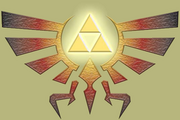
Hyrule Symbol
While certain landmarks of Hyrule commonly return, Hyrule's geography appears to be laid out differently with almost every new game set in it. Parts of Hyrule found in one game's map may be in a different location, have different geographical features, or be completely absent in another. While some games may take into account the geography in past Zelda games (A Link to the Past and Four Sword Adventures share almost the same Hylian geography) others may completely ignore them (The Minish Cap's Hyrule bears almost no resemblance to any other game). Several fan explanations have been given. The first is that the changes occurred because of geological events between the games such as earthquakes, mudslides, erosion, forest growth, continental drift, or all of the above. The second theory is that Hyrule's geography stays relatively the same but that each new game shows the same Hyrule seen from a different angle, that landmarks are renamed, or that other unseen parts of Hyrule are seen each game.
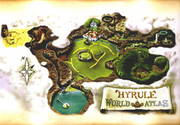
Hyrule Map
Some fans argue that while Hyrule does change from game to game it is simply due to gameplay reasons to give players something new to explore while staying in the same land and has no real in-game explanations.
It is also possible that different parts of Hyrule are shown throughout the various games. In The Legend of Zelda comics, the map from Zelda II: The Adventure of Link is added to the north of the map found in The Legend of Zelda, and the in-game map for Zelda II: The Adventure of Link also has an area that resembles a scaled down version of the map in The Legend of Zelda. The geography then allows the map from A Link to the Past to be included to the west.
Five Stages of Grief[]
Skull Kid & Majora's Mask[]
Link’s antithesis throughout these proceedings is the Skull Kid. We hear from one of Grandma’s stories that Skull Kid, as the "imp," was once the friend of the Four Giants, but when faced with the prospect of losing them to their slumber in the four corners of the world, he fell into deep despair. In his grief, he tormented the peoples of the four lands, and as a result lost his friends. That same grief gets absorbed by Majora’s Mask as it feeds off of Skull Kid’s emotions. As a result, when Link faces Skull Kid at the top of the Clock Tower, it manages to take on a life and personality of its own, creating a psychological dimension in which Link must face it in one final showdown.
By surrendering the masks he's collected on his journey - in essence providing proof of his battles against grief - Link earns the Fierce Deity's Mask, which is described as "containing the merits of all the masks." That this mask transforms Link into an adult form in contrast to Majora’s Mask’s own child-like form signifies the maturity he has gained by overcoming grief. That maturity gives him great power, with which he can easily vanquish the comparative weakness of grief and despair.
Taken out of the shadow of grief, we see that Skull Kid is able to reconcile with his old friends and find peace in their departure. But we also see that this parting is not the end. As the story closes, we note that he has returned to the Lost Woods together with Link, his new friend.
About Themes in Motion[]
Themes in Motion was an article project I started up a little over a year ago, aimed at exploring the thematic elements packed into each story in The Legend of Zelda series. I’ve already carved my way through all of the games, but for Majora’s Mask‘s birthday I wanted to give it a special second look. The idea that Majora’s Mask is a trip through the five stages of grief is not my own original conception, but it’s one that I find tremendously profound and I hope I’ve done it some justice.
Clock Town - Denial[]
Link arrives in Termina through the Clock Tower, which ticks ever onward in its countdown to the Carnival of Time, the great festival that comes each harvest time. As the people live out their everyday lives, running errands, making appointments, and setting up for the carnival, an ominous Moon looms overhead, threatening to crush the whole land.
Because of his Deku Scrub form, Link is confined in terms of where he can go and what people are willing to tell him, but a visit to the Mayor’s office reveals an important struggle brewing just beneath the surface of all the goings-on:
You cowards! Do you actually believe the moon will fall? The confused townsfolk simply caused a panic by believing this ridiculous, groundless theory. The soldiers couldn’t prevent the panic, but outside the town walls is where the danger is! You want answers? The answer is that the carnival should not be canceled!
- "If the soldiers wish to run, then run, Viscen! We councilmen will stick to tradition. This carnival will be a success! I’ve never heard of a defense unit abandoning its town!"
- - Mutoh the Carpenter
What seems like a petty squabble between bureaucrats we can actually interpret as a metaphor for denial. The Carnival Committee, unwilling to acknowledge and account for the looming danger, choose to ignore it rather than deal with it. They laugh openly at the idea that the moon will fall, and refuse to allow it to interfere with the Carnival. Similarly, the master at the sword training center entertains the idea that if the Moon comes too close, he can simply cut it to pieces with his blade. In both cases, we see an inability to grasp the reality at hand and foolish fantasies arising to take its place.
The denial can only ever be temporary, however. Eventually most of the Carnival Committee is forced to face the music as the Moon, drawing ever closer with each passing hour, gradually becomes more and more difficult to ignore. By the night of the third day all of the carpenters and merchants have evacuated, leaving only Mutoh and all his stubbornness behind. The sword-master has retreated to a back room, where he lies trembling in fear and despair.
In contrast, Link spends his every waking hour in pursuit of the Skull Kid in the hope that he can retrieve his Ocarina of Time before it’s too late. By midnight on the third day, his efforts have brought him to the top of the Clock Tower, where he stands face-to-face with the giant Moon. But, armed as he currently is, he has no way of stopping it, and in the end he too is forced to enact a sort of denial by using the Song of Time to reverse the flow of time, undoing the events leading up to the great fall and giving himself a second chance to set things right.
Woodfall - Anger[]
When Link arrives at the Deku Palace at the heart of the Southern Swamp, he discovers another case of grief: the Deku Tribe’s princess has gone missing. As he inquires about the situation he meets the leader of the tribe, the Deku King, a rather ridiculous despot hell-bent on punishing a young monkey, whom he believes has made off with his daughter and fed her to monsters in Woodfall Temple.
- "We’re about to punish the foolish monkey who kidnapped the Deku princess! He has insulted the Royal Family. I’ll show him what happens when you do that! That foolish monkey is up in that cage. Take a good look at his face!"
- - Deku King
There’s one glaring problem with the proceedings, however - the monkey is completely innocent. In fact, when the princess went missing he was working together with her to investigate the source of the vile swampwater flowing forth from the temple. Rather than putting his energies at work in search of the princess, he instead takes his anger out on the poor monkey. The real villain at work is anger - the evil sown by the Skull Kid, manifesting in the cursed swamp, the toxic rifts that divide us in moments of rage, and the fury and might of the Deku King himself.
Link tasks himself with diving deep into the temple in order to purify the swamp and rescue the princess. To get inside, however, he needs to learn the Sonata of Awakening, which has the power to lift the temple from its resting place beneath the bog. The image of the temple rising out of the infested waters exemplifies the casting off of ill emotions, and the mad warrior demon Link defeats at the core of the temple signifies the inner struggle between controlled and uncontrollable moods.
In the end Link manages to pacify that anger, snapping the Deku King back to his senses and freeing both the region and the monkey from what would otherwise have been torturous fates.
Snowhead - Bargaining[]
Link’s next trip takes him north, into the high, snowy mountains of Snowhead. There he encounters the Gorons, another tribe in mourning due to the recent loss of their patriarch, Darmani. After some careful investigation, Link meets Darmani’s ghost, who beckons for him to give pursuit. Above Darmani’s grave, the deceased Goron hero delivers his last request:
- "As I am, I can only watch as Goron Village is slowly buried in ice…I may have died, but I cannot rest. So, you can use magic? The soaring one also told me that you are able to use it… I beg you! Bring me back to life with your magic!"
- - Darmani's Ghost
Darmani’s futile hope to be brought back to life is a textbook example of bargaining. Unable to face his failure or his people in order to find closure, he turns to magic as a means of undoing his death in order to finish his battle with the demon. In a way, we can see bargaining as a sort of second denial, no longer fueled by anger but instead by foregone hope in the face of fear.
Just as Clock Town’s denial was represented by the elephant in the room that was the falling Moon, and the divisive anger of Woodfall was thematically shown in the toxic sludge infesting the Southern Swamp, the bitter, paralyzing cold of Snowhead exists as a mirror of Darmani’s inability to move on. Only once doused with the refreshing heat of Hot Spring Water and pacified from his desperate desire to see his dying wishes through is he able to find his resting peace - a peace symbolized by the Gorons’ Lullaby.
In Darmani’s guise, Link conquers Goht, a mechanical bull of sorts that moves constantly in a circuit around his arena, unstoppable except by the strength of a Goron hero. Goht for us represents a futile, circular effort to claw one’s way back to a reality that is already lost. By defeating him, Link puts an end to the demon’s seemingly-endless romp, just as Darmani is able to rest in peace only by bringing his hopeless desire to keep on living to a grinding halt.
Great Bay - Depression[]
Link meets the dying Mikau on the coastline of Great Bay, where he learns about the guitarist’s girlfriend, Lulu, and her missing eggs. Though Mikau’s passing would by itself be plenty of cause for grief, with the Zora Mask Link is able to assume the part-time musician, part-time hero’s life seamlessly, as though he has never left. This nonetheless leaves Lulu in isolation, gazing out to the Great Bay Temple from the outside of Zora Hall. Her isolation reflects depression, the fourth stage of grief.
Because Mikau’s death is more or less irrelevant thanks to Link’s ability to take on his form, we know that Lulu’s seclusion must have something to do with her missing eggs. We can infer that her maternal relationship to the eggs probably only serves to heighten her low emotional state. That she seems to have only recently laid the eggs also suggests a possible postpartum dimension to her depression. And, just as the other regions served as apt images of their corresponding grief stages, we can see the Great Bay as a collection of Lulu’s spilled tears.
Only by singing the tune born from her offspring, by reestablishing a connection to what was lost through vocal expression, can Lulu come out of her slump. In a way we can make yet another comparison to a type of maternal depression - that experienced by young mothers who have miscarried. The act of naming the lost child can lead to a sense of closure. Here, the act of singing - each note representing one of the eggs - accomplishes the same.
Inside the Great Bay Temple, Link also works to reconnect - though for him this is about redirecting water flow through the various pipes twisting throughout the dungeon. Inevitably, getting all the water flowing again restores life to the place, leading him to the final confrontation with Gyorg, during which he dives headfirst into that pool of tears and emerges victorious. His success is celebrated by a musical performance in the Zora Hall - a mirror to Lulu’s own performance of the New Wave Bossa Nova.
Ikana Valley - Acceptence[]
Ikana Valley, the land of the dead - what a fitting place for Link to resolve his own grief. Other regions had him encounter a plethora of characters, each dealing with their own losses, but apart from a young girl and her mummified father, everyone else in Ikana is basically already dead. In much the same way, Link finds no new transformation masks here - no new identities to assume. This leaves Link free to reflect on the one element he’s been distracted from during the rest of his journey: himself.
In order to fulfill this process of examination, he climbs a tower leading into the heavens, which requires that he create twin images of himself to progress. These images, one for each of his four forms, lifeless and devoid of true personhood, represent the empty shells of the previous four stages of grief. By leaving them behind, he can transcend and attain enlightenment - the Light Arrows - at the pinnacle of Stone Tower. The act of flipping the tower puts the heavens at his feet, assuring us of his ascendance.
Within the Stone Tower Temple, he battles the Garo Masters. Since the Garo are, according to their official description, "emptiness cloaked in darkness," Link's duels with them as he climbs towards the light signifies the internal battle between Light and Darkness, as well as the triumph over the same emptiness associated with his twin selves. By accepting and overcoming the grief associated with that emptiness, Link demonstrates that he is no longer troubled by the loss of his dear friend. He has found himself, his true self, and that is enough.
Happy Mask Salesman[]

Happy Mask Salesman
- "I own the Happy Mask Shop. I travel far and wide in search of masks..."
- - Happy Mask Salesman
The Happy Mask Salesman (お面屋 Omen'ya?, "Mask Shop Owner") is a recurring character in the Legend of Zelda series. He is a traveling collector and seller of strange, rare, and unusual masks. He is often considered one of the most unnerving characters in the series, due to his erratic behavior, unpredictable temper, strange powers, and occasional displays of hysteric outbursts. Partly due to his unique and mysterious demeanor, there are many theories as to the Happy Mask Salesman's true identity and motives; in The Legend of Zelda: Majora's Mask, he gives Link many subtle hints that he may be more than a common collector of masks.
Motives[]

The Happy Mask Salesman appears to be more than a simple salesman. He seems to know all about Link and his accomplishments in Hyrule and can tell what Link went through to obtain a particular mask or the power inherent in the mask, without ever seemingly leaving his post in the cave beneath Clock Town's clock tower. This is not his only strange characteristic - he also seems to appear as if from nowhere, appears to change from one pose to another instantly, and has been seen vanishing into thin air. He also manages to make a giant exaggerated piano appear from out of nowhere to teach Link the "Song of Healing". After Link learns the song, it disappears. Also, if three days pass and Termina is destroyed, Link appears back under the clock tower where the Salesman waits. Though this could also be interpreted as the game resetting to the moment before the dawn of the first day, the Salesman's laugh is heard just prior to the reset, accompanied by dialogue he had spoken previously, suggesting the Salesman may have transported Link back through time.
He also exhibits a flaring temper - he shakes Link violently from the neck when Link returns without Majora's Mask, and he has hysteric, unnerving fits. He seems to be largely benevolent during the course of the game, seems genuinely worried over the damage the Mask could wreak, and seems satisfied when he discovers that Majora's spirit has been driven from the mask. However, his motives are never explored. Furthermore, he seems to have willingly freed Majora's Mask, which shows questionable morals. His knowledge of the mask and his efforts to uncover it imply he was not worried by the threat it posed, and he seems only to have become concerned after he beheld the accursed object. It is never clear what he plans to do to the mask (or whether he has already tried to do anything). It is implied that the mask gets the Skull Kid to steal it, which indicates it was in some way restrained or unfulfilled under the possession of the Happy Mask Salesman.
However, in the non-canonical Majora's Mask manga, he displays a new more sinister side of himself (see above).
Ancient One[]
It is possible the Mask Salesman is an Ancient One, or descendant thereof, himself. Although he says the tribe itself has disappeared, this could only refer to the original members, and not include any offspring they subsequently had. The strongest evidence for this theory is his unusual knowledge of the tribe's history and actions. Also, his means of trapping evil magic and troubled spirits within masks through the song of healing is quite feasibly something the Ancient Ones used to effect the spirit of Majora's confinement within the mask. He has unusual and powerful magical abilities (teleportation, apparition of the piano). The Ancient Ones are already described as magic users, and their sealing of a vastly powerful mask within shadow indicates a similarly unusual and powerful magic.
He says that since the tribe disappeared, no one knows the power of the mask; however, he also claims he can feel its power--a trait possibly inherited from those who knew its power. His strong desire to acquire and then to regain the mask could be connected to an inherited sense of responsibility, or the fact that only an Ancient One's descendant could have the knowledge to control it. This may be reinforced by the masks own desire to escape from him using the Skull Kids actions. The final hint is that the field Majora created in the moon had five Lunar Children, who all resembled the Happy Mask Salesman himself. If the Mask Salesman's race and ancestors were the original wearers of the mask, it could explain why Majora chose people in that image to wear the five masks.
Deity[]
The Happy Mask Salesman's mystical powers and vast amount of knowledge could denote that the Happy Mask Salesman is not a Hylian, but rather, a Deity or the earthly avatar of one, or in the very least a higher being not of Terminan or Hyrulean soil. The Salesman can, as previously noted, make items, as well as himself appear and disappear at will. These attributes combined with the aforementioned facts makes a case for the Happy Mask Salesman in truth being a god, perhaps one who guides those who are lost.
He also may have limited control over the flow of time, as when Link is inside the Clock Tower, time does not pass; in fact, the in-game clock disappears entirely. This could be taken further to suggest that the Happy Mask Salesman is, in fact a personification of the Goddess of Time, which is further supported by the fact that Link is taken back to his meeting with the Mask Salesman if he fails to stop the Moon. If that is true then he may be the same character in Oracle of Ages as in the Majora's Mask and Ocarina of Time.
The nature of this deity may also be that of an inter-dimensional hero, explaining his presence in both Ocarina of Time and Majora's Mask. This hero may be someone who cannot directly intervene in grave matters, but can assist the people of whatever dimension he is visiting (much like the mask salesman teaches Link the Song of Healing and seems to be aware of Link's time travel).
Sheikah[]
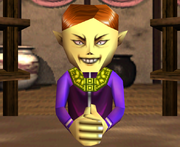
Due to the fact that his eyes are, for the most part, closed, it is hard to determine the color of his eyes. However, when he opens them during one of his violent outbursts, they are red. Red eyes are a characteristic commonly connected to the Sheikah. However, the red eye color may stem from the fact that the eyes are bloodshot during his frantic episodes. Additionally, in Ocarina of Time, the Happy Mask Salesman gives Link the Mask of Truth as a reward for selling his masks. The Mask of Truth is a well-known artifact of the Sheikah race. It could be that he somehow obtained the mask during his travels, but it could also have been passed down to him by his would-be ancestors, the Sheikah.
While non-canonical, in the manga, the Happy Mask Salesman's eyes are occasionally open, but since the manga is printed in black and white, it is impossible to determine the eye color. However, the brightness of the irises suggests that the color is a light color, obviously ruling red out, unless it is a lighter shade of red.
Shigeru Miyamoto[]
Another belief is that the Happy Mask Salesman is an in-game avatar of Shigeru Miyamoto, the creator of the Mario series and the Legend of Zelda series. This theory is compounded by his seemingly unlimited knowledge, strange powers, and the appearance of masks resembling Mario and King Dedede, both of which are Nintendo characters. Additionally, Shigeru Miyamoto has stated that as a child, he had dreamed of directing puppet shows before getting into gaming. This could be a further reference to the Happy Mask Salesman, who, in the game, seems to be influencing all of the events from behind the scenes.
Anton[]

Anton
It is possible that Anton shares some sort of connection with Pamela's Father from The Legend of Zelda: Majora's Mask, as the two look mildly similar and wear the same style shirts.
Baito[]

Baito
Due to their similar appearance and shared profession as a part-time worker, some believe that Baito from The Legend of Zelda: The Wind Waker is a descendant of the Part-time Employee from The Legend of Zelda: Majora's Mask.
Bremen Mask[]

Bremen Mask
- "That is the Bremen Mask, isn't it? If you have that, then it would appear you have the qualities of a leader."
- — Happy Mask Salesman
The Bremen Mask (ブレー面, Bure Men?) is one of twenty-four masks Link can collect in The Legend of Zelda: Majora's Mask. This mask has the power to control small animals, and make them march behind him. Strangely, when used, this mask speeds up the aging process of certain animals controlled by it, allowing Cucco Chicks to grow into adults within a very short range of time. The song the mask emits when activated with the B button is somewhat similar to a march. When the mask is being used, Link plays the aforementioned song on the Ocarina of Time.
Origin[]
The Bremen Mask is believed to be a reference to Falco Lombardi, an anthropomorphic falcon from the Star Fox series. Falco is sometimes envious of his colleague Fox McCloud, similar to how Guru-Guru stole the Animal Troupe's leader's mask out of jealousy. It is one of five masks that are a supposed reference to Star Fox, along with the Bunny Hood, Don Gero's Mask, the Keaton Mask, and the Mask of Scents.
Bunny Hood[]
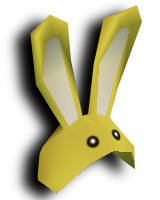
Bunny Hood
The Bunny Hood (ウサギずきん, Usagi Zukin?) is a recurring mask in the Legend of Zelda series. As its name suggests, the mask resembles the upper head of a rabbit, including the eyes and ears. The ears will flop around due to a "jiggle-bone" program when Link walks or perform most other movements such as using the sword and/or jumping.
Pols Voice[]
The Bunny Hood bears a resemblance to a Pols Voice, a recurring enemy in the series. This may not be a coincidence, however; when Link sells the Bunny Hood to the Running Man in Ocarina of Time, he states upon receiving the mask, "I bet with those long ears you can hear the voices." This quote may very well indicate a connection between the Bunny Hood and the Pols Voice. The Bunny Hood itself may simply be a reference to The Legend of Zelda: A Link to the Past, in which Link becomes a bunny in the Dark World before obtaining the Moon Pearl.
Star Fox[]
The Bunny Hood is believed to be a reference to Peppy Hare, an anthropomorphic hare from the Star Fox series. Peppy is a decidedly positive and optimistic character, similar to Grog's attitude before presenting Link with the Bunny Hood. It is one of five masks that are a supposed reference to Star Fox, along with the Bremen Mask, Don Gero's Mask, the Keaton Mask, and the Mask of Scents.
Butterflies[]

Butterflies
Butterflies turning into fairies through player interaction may be a reference to Super Mario 64, in which butterflies turn into 1-up Mushrooms (or, occasionally, explosive bombs) when Mario punches or kicks at a swarm of butterflies.
Clock Town Bank[]

Clock Town Bank
The relocation of the Clock Town Bank to being a part of the Clock Tower in the 3DS remake of the game provides a logically plausible explanation for how the Bank is able to retain the Rupees Link has deposited after Link travels through time, as the inside of the Clock Tower is seemingly unaffected by the passage of Time in Termina possible due to its close proximity to the portal that links Termina and Hyrule potentially causing a localized distortion in space-time inside the Clock Tower, the caverns underneath, and the Clock Town Bank (and/or it's rupee vault).
Clock Town Carnival Executive Committee[]
It is never explicitly stated, but it is possible that the Man from the Bomb Shop and his mother are part of the Clock Town Carnival Executive Committee. This seems likely due to the fact that a sign from the committee tells of the fireworks show, and the Man from the Bomb Shop tells Link of the fireworks show personally. Also, explosives are needed to produce fireworks, but this fact can be overlooked since it is possible the Carnival Committee simply buys the supplies needed.
Composer Brothers[]

Sharp

Flat
The Composer Brothers may be based on Mario and Luigi, another pair of siblings of Nintendo. This is supported by the fact that Sharp is the elder brother, short, somewhat wide, and wears red, which is similar to Mario, and Flat is the younger brother, tall, thin, and wears green, which is similar to Luigi; additionally, the Composer Brothers both have mustaches, as do Mario and Luigi. Furthermore, the inscriptions on their gravestones read "Royal Composer Bros."; this truncated form of "brothers" may be a reference to Super Mario Bros.
Deep Python[]

Deep Python
Deep Pythons bear resemblance to Unagi the Eel from Super Mario 64 in appearance, movement and habitat. Because of this, it is possible that Deep Pythons were inspired by the enemy.
Deku Butler[]
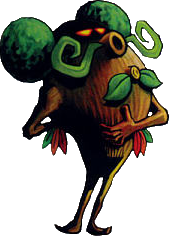
Deku Butler
There are some theories pertaining to what happened to the Deku Butler's son. It is implied, though not confirmed, that the sad twisted tree beneath Clock Town is his long-lost son, as the Deku Butler is seen crying next to it during the credits. A common belief is that the Deku Butler's Son ran into the Skull Kid, who had then rendered him lifeless to gain the ability to transform Link into his Deku Scrub form.
Link is transformed into a Deku in the same tunnel complex near the twisted tree shape. Therefore it is also believed that the Deku Mask may hold the stolen soul of the Deku Butler's son, as the other transformation masks, the Goron and Zora Masks, contains the spirits of the dead Darmani and Mikau. Since the Goron and Zora masks transform Link into people of importance who are also deceased (Darmani and Mikau), the Deku Mask has been thought to transform Link into the shape of the Deku butler's son.
Before Link leaves the Deku Shrine after having led Link to the end, the Deku Butler apologizes for moving too fast; he mentions that when he looks at Link, he is reminded of his son, whom he used to race, and that he therefore forgot to lower his pace. It is possible he is referring to Link's Deku form which he saw previously, as this is the most likely form to remind him of a Deku Scrub, though at the time he makes this statement Link may or may not be using that shape. This theory is further supported by the Deku Scrub statue created by playing the "Elegy of Emptiness", which looks notably similar to the twisted tree and different from Link's Deku form; it has three leaves on the top instead of hair for example. The statues of Link's other forms, in two cases, resemble the physical forms of the spirits sealed inside the transformation masks, rather than resembling Link's forms when using the masks.
Deku Butler's Son[]
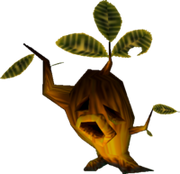
The masks that cause Link to transform in Majora's Mask all seem to be inhabited by another character's soul. The Goron Mask houses the soul of Darmani, the Zora Mask houses the soul of Mikau, and the Fierce Deity's Mask presumably houses the soul of a great god. This leaves the Deku Mask with no real explanation as to how it helps Link transform.

When Link first enters Termina, the Skull Kid puts a curse on him, turning him into Deku Link. Soon after, Link stumbles across a twisted tree that resembles a Deku Scrub. Tatl remarks on how the tree "looks sad", as well as its physical resemblance to Link's current form. Later, when Link is to receive an item from the Deku Butler, the butler initiates a "race" in which he guides Link through a series of obstacles; if Link is able to keep up with him and reach the end of the shrine, he is given the Mask of Scents. Before Link leaves the shrine, the Deku Butler apologizes for moving too fast; he mentions that when he looks at Link, he is reminded of his son, whom he used to race, and that he therefore forgot to lower his pace. It is possible he is referring to Link's Deku form which he saw previously, as this is the most likely form to remind him of a Deku Scrub, though at the time he makes this statement Link may or may not be using that shape. During the game's end credits, the Deku Butler can be seen crying next to the twisted Deku-like tree seen in the caverns underneath Clock Town, which may imply he has finally found his long-lost son.


It is possible that when the Skull Kid cursed Link, he somehow infused him with the spirit of the Deku Butler's Son, which he may have somehow "extracted" from his body, leaving him a twisted tree somewhat reminiscent of his living form. When Link broke the curse with the "Song of Healing", he sealed the spirit of the Deku Butler's Son inside the mask. This theory is further supported by the Deku Scrub statue created by playing the "Elegy of Emptiness", which looks notably similar to the twisted tree and different from Link's Deku form; it has three leaves on the top instead of hair for example. The statues of Link's other forms, in two cases, resemble the physical forms of the spirits sealed inside the transformation masks, rather than resembling Link's forms when using the masks.
Deku Link[]

Just as Link's Goron and Zora forms each transform him into the shape of a recently deceased being, many believe that Link's Deku form is that of an existing being. It is heavily hinted at that the mask holds the spirit of the Deku Butler's Son. Early on in the game, Link discovers a dead tree that resembles his new Deku form. Tatl comments on this, noting the sadness in its face.

This is not elaborated upon until after the completion of the Woodfall Temple. After Link manages to keep up with the Deku Butler throughout the maze-like Deku Shrine, the butler presents Link with the Mask of Scents, once owned by his lost son. He also mentions how Link reminds him of his son. During the game's ending, the Deku Butler is seen kneeling in front of the withered tree, implying that it is the remains of his long lost son. Additionally, when the "Elegy of Emptiness" is played, a shell of Link's current form is created. Link's Goron and Zora forms shed statues which look like the individuals the two masks were created from, rather than appearing as Link does when he wears the masks. In this vein, the Deku Mask's statue is similar in appearance to the withered tree, and decidedly different from Link's Deku form.
In the Majora's Mask manga, the Deku Princess displays romantic feelings for Deku Link, and the physical similarities between Deku Link and the Deku Butler's Son are noted yet again.
Deku Royal Family[]

The Deku Royal Family is a group from The Legend of Zelda: Majora's Mask. It consists of Dekus that are the members of the traditional monarchy that rule Woodfall, the southernmost region of Termina.
Missing Deity[]
When Link encounters Kaepora Gaebora along the Woodfall Shortcut, he says the swamp has lost its deity but it was destined to fade anyway. He also mentions that this was so ever since their deity went missing. It seems plausible that the deity is the Giant of Woodfall, due to the fact that it has been sealed away in Woodfall Temple. It should be noted however, that the non-canonical manga states that Odolwa is their deity.
Soviet Union[]
The Deku Kingdom seems to be based on the Soviet Union. The architecture and music of the Deku Palace is similar in style to the Russian style of architecture and Slavic folk music respectively, and the Deku's ignorance, distrust, and hatred of outsiders mirrors the "Iron Curtain" technique utilized by the USSR, which involved "locking out" foreigners and disallowing any negative media to leave the country. Also, the Deku King's personality and appearance (particularly his mustache) bear resemblance to Soviet leader, Joseph Stalin, while the Deku Princess bears slight resemblance to Stalin's daughter, Svetlana Alliluyeva.
Deku Shrine[]

Deku Shrine
It is possible that the Deku Shrine functions as a home for "common" Deku, given the many Mad Scrubs inside, and the fact that no other notable Deku population center is seen, aside from the Deku Palace itself, which is off limits to all those other than royalty and royal servants. However, the Deku Shrine does not appear to be designed as a dwelling, and Deku may not need anything other than a Deku Flower to live in to begin with. Also, rather than residents, the Mad Scrubs in the shrine may be guards as they are in other areas, and are peaceful because Link is welcome in the shrine.
Deku Tree Sprout[]

Deku Tree Sprout
The Deku Tree residing in the Forest Haven in The Legend of Zelda: The Wind Waker is believed to be the mature Deku Tree Sprout from Ocarina of Time. It watches over the Koroks, a race that is suggested to have once been the Kokiri. This is supported by the fact that this Deku Tree does not speak archaically. Rather, it speaks Hylian, which was in use during the events of Ocarina of Time. It also recognizes the green tunic that Link wears.
Destruction of Termina[]

Destruction of Termina
Some believe that the Happy Mask Salesman saves Link by resetting the three-day cycle. Some evidence for this theory includes the prior laugh and quotation of the Happy Mask Salesman, and the first sentence he speaks to Link when he restarts under the Clock Tower, which is not something he says to Link during any other time loop, though nothing happens that directly suggests the Happy Mask Salesman does anything to save Link.
Others also believe that the sudden draw-back to the very beginning without the use of the Song of Time, can somehow be interpreted as Link's very own indirect doing. The 'Resetting' of the Time Cycle, may be attributed to Link's dormant abilities as The Hero of Time. Therefore, when faced with an inescapable scenario (such as the moon crashing and facing the incoming firewall) Link's survival instinct took over, allowing his Hero of Time spirit to awaken to save his life.
Another theory is that the Goddess of Time resets time, keeping Link from dying. Evidence supporting this is that Princess Zelda told Link, "The Goddess of Time is protecting you." It is possible that the Goddess of Time is resetting time either to prevent the death of the Hero of Time or to prevent the destruction of Termina. Both of these motives are plausible, as it seems that the Goddess of Time is a respected Deity in both Hyrule and Termina.
Devil[]
With the curse broken by the "Song of Storms", water is again allowed to flow from Spring Water Cave, and Sharp is no longer found there. Both of these will also be accomplished if Link loops time to before the curse is lifted and clears Stone Tower Temple. This would seem to indicate that the "devil" responsible for Sharp's curse is the same being as the one responsible for the curse stemming in Stone Tower Temple, as the former is apparently dependent on the latter. However, it is possible that the game designers assumed Link would have broken the curse on Sharp and cleared Stone Tower Temple in the same time loop, so they did not program a scenario in which Sharp would still be cursed after Link clears Stone Tower Temple.
Don Gero's Mask[]

Don Gero's Mask
Don Gero's Mask is believed to be a reference to Slippy Toad, an anthropomorphic toad from the Star Fox series. It is one of six masks that are a supposed reference to Star Fox, along with the Bremen Mask, the Bunny Hood, the Keaton Mask, and the Mask of Scents.
Fierce Deity[]

Fierce Deity
Though the history of Fierce Deity is never elaborated upon in the game, it is implied, through what is said by the likes of Tatl, and the fact that Majora himself gives Link the god's mask, that the Fierce Deity's Mask was created by a being far stronger than Majora, and that Majora could possibly have given the mask to Link in an effort to destroy them both. Fierce Deity's powers may be even darker than that which resides in Majora's Mask, as Majora calls him "the true bad guy", though this may just be a lie or exaggeration on the part of Majora, and that Majora considers itself a hero. This statement is only present in the dubbed version however, and not the original Japanese version.
Another theory is that the Fierce Deity is Link's termanian counterpart, due to the resemblance between him and Link, as no definite counterpart to Link is seen in-game. Though Link's other alternate forms retain some aspects of his appearance, the transformation masks themselves do not. However, the Fierce Deity's Mask itself shares Link's hat and some of his facial features even when not in use, and while in use, Fierce Deity Link's voice is the same as that of Adult Link from The Legend of Zelda: Ocarina of Time. The description of the mask as being filled with dark power does not affect this theory, since morality is not always consistent between Hyrulian and termanian counterparts, as seen by the differences between the two incarnations of Talon and Mr. Barton. The Fierce Deity's status as a god would seem to indicate that it is not Link's equivalent, though its power could also be interpreted as a more direct embodiment of Link's defining characteristic of being destined to accomplish legendary feats.
Though there is little evidence to support this theory, it has been suggested by some that when Majora realizes Link is a threat, it seals its spirit into the Fierce Deity's Mask instead of Majora's Mask in order to survive. If Link chooses to wear the mask, he succumbs to a great power, defeating Majora easily. If he chooses not to, he must face a far more difficult battle, but has not given into the possible trickery of Majora. This theory presents the Fierce Deity's Mask as a moral choice to the player; whether or not to use the possibly evil powers of "the true bad guy" to defeat a final boss. Moral choices are rarely present in the Legend of Zelda series, but it would make sense that one of this magnitude would be present in Majora's Mask, a game known for its intricate plot. This would explain why such a powerful weapon is simply gifted to Link, and would maybe reveal a darker, unseen ending to Majora's Mask. By wearing the Fierce Deity's Mask, Link sells his soul much in the same way that the Skull Kid had done with Majora's Mask. Therefore, when Link returns the emptied Majora's Mask to the Happy Mask Salesman, Majora has tricked both the Happy Mask Salesman and the player, and could survive on in the Fierce Deity's Mask. It could also explain why the final boss battle appears to feature incarnations of Majora and may never show the entity's true form. This theory does not explain how Majora would continue to act through Majora's Mask while inhabiting the Fierce Deity's Mask, if it would even be possible for the entity to leave Majora's Mask, and why Majora would give Link such awesome power rather than wield it itself. According to the Hyrule Historia however, the Hero of Time lived long enough to have at least one child which leads to his descendant, the Link in Twilight Princess whom he assisted as the Hero's Shade, showing that he wasn't controlled by any evil entities whatsoever.
Fierce Deity's Mask[]

Fierce Deity's Mask
Some believe that the Fierce Deity was a nemesis of Majora's, possibly the hero who sealed Majora into the mask long ago, as is implied in the Majora's Mask manga.[1] If this is the case, then Majora likely gives Link the mask in order to defeat both Link and the spirit inhabiting the mask at the same time. This theory assumes that the Lunar Child wearing Majora's Mask is influenced by or is himself a personification of Majora.
It has been theorized that the "Fierce Deity" may be Link's Terminan counterpart, due to their similar appearance and voices. The voice similarity could be explained by the fact that Link's voice and clothing are partially preserved in his other transformations, however the Fierce Deity's Mask itself has a similar face and hat.
Unlike the other three transformations masks, the Fierce Deity's Mask uses the possessive form of the word, implying that the mask itself once belonged to a Fierce Deity, as opposed to the deity's soul being sealed inside the mask. Though it should be noted that the gossip stone located on the opposite side of the river to the Deku Scrub in Ikana Canyon refers to it as the "Fierce Deity Mask".
Giant's Mask[]

Giant's Mask
Because the Giant mask can be used exclusively inside Twinmold's arena, some speculate that the mask does not cause Link to grow in size, but instead. Given the peculiar nature of Stone Tower Temple, this theory is not so outlandish. However, if one uses a glitch that allows Link to wear the Giant's Mask in Sakon's Hideout, Link will start to grow larger when the mask is equipped, but will stop once he reaches the ceiling, and remains in the transformation sequence, requiring a reset. It should be noted that this is a glitch and was never intended to be possible by the game's developers. This theory also contradicts the mask's name and in-game description, which specifically imply that the user is actually growing. However, the fact that Link cringes and screams when putting on the mask, like any other transformation mask, also implies that he is undergoing a painful physical transformation, something that would not happen if the arena was affected as opposed to him.
Great Swords[]

Great Swords
The Great Swords are the default weapon type of Ganondorf in Hyrule Warriors. They are described as a set of giant swords brimming with dark power. This weapon type has a Darkness Elemental Attribute and its Strong Attack allows Ganondorf to fill his dark energy gauge in order to unleash the collected dark energy in a powerful attack. Ganondorf can also envelop himself in a shadowy shroud that resembles a shadowy version of his Ganon form.
Ganondorf's Level 3 weapons are the Swords of Demise, while their 8-Bit versions are the 8-Bit Magical Keys.
Gerudo Fighting Style[]
Ganondorf's dual Great Swords may be based on Gerudo Guards from The Legend of Zelda: Ocarina of Time and The Legend of Zelda: Majora's Mask as they also wield two swords in combat. This also indicates the possibility that Gerudo train in the art of wielding two swords in combat. Additionally both Ganondorf and the Gerudo Guards guard against attacks by crossing their dual swords together. Alternatively, Ganondorf developed the style himself and it was later adopted by the Gerudo Guards seen in Ocarina of Time. Ganondorf (in The Wind Waker) and Ganon (Ocarina of Time) are both known to dual wield swords/blades in final boss fights indicating it may be his preferred weapon style.
Hero's Bow[]
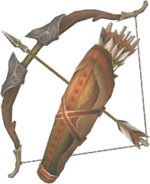
Hero's Bow
In The Legend of Zelda: Twilight Princess, Dangoro states that the bow Link obtains was used by "an ancient hero". Given that The Legend of Zelda: Majora's Mask is officially placed before Twilight Princess in the timeline, it is possible that the Hero's Bow in Twilight Princess is the same as the one Link uses in Majora's Mask. However, Link was not known as a hero in Hyrule at the end of Majora's Mask, so for this theory to be true, he would need to have made a name for himself in Hyrule some time after the events of Majora's Mask. It was stated in the Hyrule Historia that the Hero's Shade (who is the Hero of Time) lamented that he wasn't remembered as a hero which further conflicts with the situation. It is possible that he actually was remembered as a hero by some, but didn't know about that for himself. This is possible, given that Ashei also mentions "the legendary hero" when she first spoke to Link and noted his clothes.
Hero's Clothes[]

Hero's Clothes
Because the Link in The Legend of Zelda: Skyward Sword was the first hero chosen by the Gods, and the knights are seen wearing the Hero's Clothes, it is possible that this is where they originated from, and from this Link they have been passed down. It is more likely however, that the Hero of Time was the one who passed down the idea as shown in Wind Waker and Twilight Princess.
Iron Knuckle[]
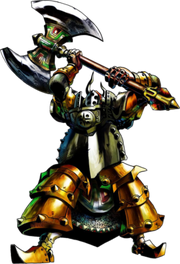
Iron Knuckle
In Ocarina of Time, if Link positions himself such that the camera moves just through the vertices that compose an Iron Knuckle's helmet (and certain other pieces of armor), a Gerudo can be seen inside. Additionally, removing the enemy's top armour piece reveals a feminine figure. It is possible that these Gerudo were brainwashed by Koume and Kotake, just like Nabooru was, as both share the same vacant, wide-eyed stare. These Gerudo may also be seen when the same process is used in Majora's Mask; however, this may simply be a case of reused models. It is also possible that during development, the Iron Knuckles' helmets were meant to fall off during the second stage of the fight, revealing the person inside. Iron Knuckles also emit yells and grunts that sound distinctively male, but so does Nabooru's Iron Knuckle form, which could be the result of the acoustics within the armor (i.e. the sound of the wearer's voice bouncing off the insides of the suit, making it deeper in pitch).

Underneath the enemy's top piece, a female physique can be seen
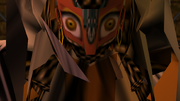
A Gerudo's face seen within an Iron Knuckle
Another possibility is that the game designers used existing Gerudo 3D models as a template around which to base the Iron Knuckle design simply for convenience, and did not intend for Iron Knuckles to be seen as Gerudo. However, this seems unlikely, as the under-the-helmet appearance of regular Iron Knuckles is noticeably different from the mini-boss Iron Knuckle, Nabooru. If the game designers were opting for convenience, all Iron Knuckles would likely bear Nabooru's character model inside them. It is also possible that the designers did not want the identity of the Iron Knuckle fought as a mini-boss revealed earlier in the game.
Kafei[]

Kafei
Kafei has red eyes, like those of Impa, Impaz, and Sheik. All known members of the Sheikah race have red eyes; however, whether or not this makes Kafei a Sheikah is unknown. Interestingly, his father, Mayor Dotour, does not have red eyes, and his mother, Madame Aroma, is constantly squinting, making it impossible to determine her eye color.
Another theory is that Kafei is Link's Terminan counterpart, much as Romani is to young Malon, Lulu is to Princess Ruto, etc. Evidence to support this may include the similar skill sets and flair for puzzle solving they share, as well as their mannerisms, build, and similar expressions their artworks display. However, the theory is refuted by the fact that these personality characteristics do not always carry over between Hyrulean and Terminan equivalents, and by the fact that the only consistent link between two such beings is their identical appearance, whereas Link and Kafei have vastly different appearances.
Kamaro's Mask[]

Kamaro's Mask
- "That's Kamaro's Mask, isn't it? That is a fine mask. It is filled with the joy a teacher has in finding a good student."
- — Happy Mask Salesman
Kamaro's Mask (カマロのお面, Kamaro no Omen?) is one of the twenty-four masks that Link can collect in The Legend of Zelda: Majora's Mask. This mask, shaped in the image of Kamaro, allows the wearer to perform a mysterious dance with the B button.
Origins[]
If one looks closely at Kamaro's Mask, there is noticeable stitching around Kamaro's neck area that attaches it to the main mask, which gives one the impression it may actually be Kamaro's head stitched onto the mask itself. This gives the mask's odd design a more disturbing possible origin.
Keaton Mask[]

Keaton Mask
- "Is that a "Kee...something..." character mask? I heard he's very popular recently?"
- — Keaton Mask Soldier
The Keaton Mask (キータンのお面, Kitan no Omen?) is a recurring mask in the Legend of Zelda series. The mask is based on the mysterious fox-like creature known as Keaton. People's reactions to the Keaton Mask indicate that it is based on a seemingly fictional character named Keaton, who is popular with the children of Hyrule and apparently Termina at one point.
Name[]
Though an actual Keaton appears in Majora's Mask, this creature is never seen nor made reference to in Ocarina of Time. As a result, the meaning of its name remains a point of speculation. It is possible that the name is meant to be a reference to kitsune, the Japanese word for "fox", which also serves as the name bestowed upon mischievous foxes from Japanese folklore in English retellings.
Pikachu[]
Though an actual Keaton is seen in Majora's Mask, and the mask in Ocarina of Time is recognized as a fox by some characters, the mask may also be a reference to Pikachu from Nintendo's Pokémon series. The mask and Pikachu have similar coloration, and both are very popular among children (in the Zelda universe and the real world, respectively). Lastly, Princess Zelda misidentifies the mask as a mouse, which is the type of creature Pikachu is listed as.
Star Fox[]
The Keaton Mask is believed to be a reference to Fox McCloud, an anthropomorphic fox that serves as the main character of the Star Fox series. It is one of five masks that are a supposed reference to Star Fox, along with the Bremen Mask, the Bunny Hood, Don Gero's Mask, and the Mask of Scents.
Link[]
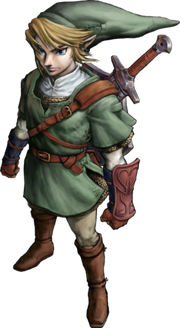
Link
Reincarnation[]
A common theory as to why each incarnation of Link looks similar and have similar abilities is that they are reincarnations of one another. It is notable that when Demise put a curse onto the Skyward Sword, Link, and Zelda, he stated "Those like you... Those who share the blood of the goddess and the spirit of the hero." which may have been referring to reincarnation. It should be noted however, that Link from The Wind Waker could not be the reincarnation of the Hero of Time since the latter went to the Child Timeline and effectively disappeared from the Adult Timeline. According to the King of Red Lions, the Hero of Winds has no connection to the Hero of Time, though it is unclear whether he is referring to blood relation or reincarnation with this statement. It is worth noting that Ganondorf believes the Hero of Winds is the Hero of Time reborn, though his claim has no concrete evidence. Link from Twilight Princess also could not be the reincarnation of the Hero of Time since, according to Hyrule Historia, he not only met the Hero of Time as the Hero's Shade, but is however his descendant.
Relatives[]
Another theory as to why each incarnation of Link looks similar to one another is that they are actually related to one another. This is supported by the fact that the Hero of Time is the ancestor of Link in Twilight Princess as well as how it is stated in A Link to the Past that the Master Sword can only be pulled out from its pedestal by the ones who carry the bloodline of the Knights of Hyrule. It is possible that when Demise stated "Those like you... Those who share the blood of the goddess and the spirit of the hero," when he put a curse on Link and Zelda, he was actually referring to the "spirit of the hero" as a form of will or a set of personality traits rather than the soul itself. If this is the case, this could explain each Link's connection with the Triforce as well as their abilities in physical, mystical, and spiritual ways.
This may mean when he was stating "Those who share the blood of the goddess" he was referring to Skyward Sword Link and Zelda's descendants as the other incarnation of Links rather than the Royal Family of Hyrule, where an alternate reason for the Royal Family having magical powers is the Light Force as hinted in The Minish Cap. This would explain why Link faces other adversaries aside from Ganon, with Zelda (or other members of the Royal Family) sometimes not being present to support the side of good in games such as as Majora's Mask, Link's Awakening and Tri Force Heroes The original Japanese text that Demise states is that his hatred and the Demon Tribe will go under an "evolution", which may mean the curse could involve other villains apart from Ganon himself.
If each Link is related to one another, they need not be related along a single line of descendants. For example, the Hero of Winds cannot be a direct descendant of the Hero of Time since the latter returned to the Child Timeline immediately after his victory over Ganon while being a young preteen in a teenager's body, but provided the Hero of Winds can trace his lineage to Skyward Sword Link, the theory still holds. It is possible that the reason why the Master Sword can only be pulled from it's pedestal by someone who carries the bloodline of the Knights of Hyrule is actually a sub-conscience decision by Fi, who is the spirit of the Master Sword.
Madas[]
It is possible that in the contemporary Hylian language during the events of Skyward Sword, Link's name may be "Madas" when pronounced. This would explain why Fi, when talking to Link in dialogue that uses his name, often says "Madi Madas" with "Madi" possibly being "Master" in the language. Alternatively, it is possible that Fi's words are gibberish used repetitively in the game, similar to Midna in Twilight Princess.
The Lost Woods[]
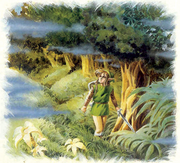
The Lost Woods
The Lost Woods is a recurring location in the Legend of Zelda series. This mysterious, forested region of Hyrule is typically a maze-like forest that requires one to navigate one's way through it by a variety of means.
The Legend of Zelda: The Wind Waker[]
It is theorized by some that the Lost Woods became the Forbidden Woods. Evidence supporting this theory is that the Lost Woods from Ocarina of Time are near Kokiri Forest, and that the Forbidden Woods from The Wind Waker are near the Forest Haven. The Kokiri Forest and the Forest Haven are theorized to be the same place, since they have similar climates and both are home to the Great Deku Tree. Also, there are stump-shaped houses inside the Forbidden Woods which look very similar to the houses of the Kokiri in the Kokiri Forest from Ocarina of Time, and a Korok tells Link that he may see some of their old houses in the Forbidden Woods.
The Legend of Zelda: Twilight Princess[]
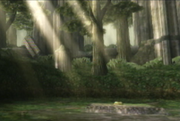
The Sacred Grove
The Sacred Grove in this game is believed by many to be part of the Lost Woods. Though this has never been officially stated; they carry identical music themes, and both woods are roamed by the Skull Kid. One of the biggest similarities between the Lost Woods in Ocarina of Time and the Lost Woods in Twilight Princess is that the area which holds the Master Sword in the Sacred Grove is exactly the same as the area where Saria sits in the Lost Woods in Ocarina of Time.
Both areas in each game are high, circular chambers deep in the forest. Also, when Link looks up in the Sacred Grove, he can actually see what appears to be the Forest Temple from Ocarina of Time, which appears as an immense archway. There is also a room with a bomb-able rock hiding an Imp Poe and the entrance to a Dig Cavern which also resembles this area.
Lulu[]

Lulu
While Lulu's Zora Eggs may cause controversy, they do hatch and become children, showing that they were indeed fertilized. Since the Zora were known to have both a mother and a father, it is only customary to assume that there is a father of Lulu's children. The only logical solvent of this would be Mikau, since he is already Lulu's implied lover. The biggest clues about Lulu's eggs can be found in Lulu's diary, and Mikau's determination to recover the eggs.
Though it is often believed that Mikau is the father of the eggs, it is also possible that they were created as a result of some kind of magic, and lack an actual father. Lulu is apparently a protector of Great Bay Temple, and as a result the eggs may have been created by magic in order to begin the chain of events necessary for the liberation of the temple. Though the origin of the eggs could potentially be explained by their implied magical properties, this does not preclude the possibility that Mikau is also their biological father.
Lunar Children[]

Lunar Children
The Lunar Children are characters from The Legend of Zelda: Majora's Mask. They are five children living on the Moon, in its grassy plain.
Lunar Race[]
- "Masks...You have...a lot. You, too... Will you be... a mask salesman?"
- — Lunar Child
The Lunar Children bear a conspicuous resemblance to the Happy Mask Salesman. It has been theorized that the Lunar Children are a race of ageless beings that have inhabited the Moon for years, and that the Happy Mask Salesman is one of them. This would account for his love of masks, his desire to spread happiness and his ability to disappear and summon objects out of into and nowhere. However, this does not explain how the Lunar Children came into possession of the boss masks they are seen wearing upon Link's arrival.
Majora[]
Another similar theory is that the Lunar Children are manifestations made by Majora that are synthesized based on Majora's experiences. They seem to draw on the physical appearance of the Happy Mask Salesman and to be obsessed with and pleased by masks. They also represent some characteristics of the Skull Kid. They are young children interested in friendship and playing. The child sitting alone by the tree while his four friends run contentedly around him might symbolize the relationship between the Skull Kid and the Four Giants. And one of the children's questions about whether everyone is made happy by the same thing seems to reflect the Skull Kid's antics, which were mischievous and irritating to other people. In all, the field and the Moon and the Lunar Children could all be an amalgamation of personalities that Majora came into contact with after being unsealed.
Madame Aroma[]

Madame Aroma
Though a seemingly minor detail it added a layer of depth to the husband & wife pair, as well as a little more meaning to Mayor Dotour's reaction to Link wearing Anju's & Kafei's Couple's Mask as it likely reminded him of the time he and Madame Aroma were young and in love, helping him realize what's important. The portrait her and her husband implies that they were both passionately in love with one another in their youth, echoing their son's relationship with Anju.
Majora[]
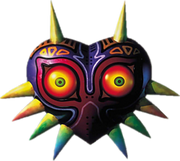
- "A puppet that can no longer be used is mere garbage. This puppet's role has just ended..."
- — Majora
Majora (ムジュラ Mujura?) is the assumed name of the main antagonist of The Legend of Zelda: Majora's Mask. An evil being inhabiting Majora's Mask, it is arguably the series' most depraved and bizarre villain. Despite appearing as an inanimate object, and using the Skull Kid as its puppet, the mask carries obvious sentience and the ability to speak coherently, through its wearer or of its own power. The gender of Majora is disputed, as neither the game nor any supplementary material states it.
The true form of Majora is arguably never seen. During Link's final battle with the spirit, it transforms into three different forms. It is possible that the appearance of Majora's Mask may somehow resemble the true appearance of Majora, if it ever even had one; however, this cannot be confirmed, but it is widely considered to be a likely possibility.
Demon[]
Another theory is that Majora was an insane demon that was defeated by Fierce Deity. Majora, in a last ditch effort to save its own life, sealed its own soul in a mask. The deity, realizing that Majora could return and destroy Termina, fused his own powers into another mask to combat the demented demon. Majora always kept the other mask near it so it could exact its revenge when it would be able to destroy Termina. So when Link was about to fight Majora, Majora could give Link the Fierce Deity's Mask in order to destroy his old enemy and his current one at the same time. This mistake causes Majora to be killed permanently. The motive may have been that Majora wanted to be worshiped by the Terminans, but was rejected, causing his thirst for the destruction of Termina.
Something to consider is that Majora states "I... I shall consume. Consume... Consume everything..", once it had taken control of the Moon directly. No explanation for it saying this is ever given but it may explain its motive. This could mean it wanted to consume the negative emotions, resulting from the destruction of Termina, making it more powerful. It could also mean that it wished for destruction to consume Termina, showing its sadistic streak. Another explanation is that Majora considered causing misery and destruction to be 'playing'. This is supported by Majora stating upon being confronted in the Moon that it wanted to play with Link and then engaging him in battle. Given Majora's obvious insanity, this is easy to explain. It's possible that the rituals it was used in made it believe this.
Twili[]
Some theorize that the tribe Majora belonged to were the early Twili. Some fans use similarities between the Fused Shadows, Zant's helmet, and Majora's Mask to support this theory. Particularly the similarity between the eyes of Majora's Mask and those of the Fused Shadows are of note in this theory.
Majora's Mask[]

Majora's Mask
- "The mask that was stolen from me... It is called Majora's Mask. It is an accursed item from legend that is said to have been used by an ancient tribe in its hexing rituals. It is said that an evil and wicked power is bestowed upon the one who wears that mask. According to legend... the troubles caused by Majora's Mask were so great... the ancient ones, fearing such catastrophe, sealed the mask in shadow forever, preventing its misuse..."
- — Happy Mask Salesman
Majora's Mask (ムジュラの仮面, Mujura no Kamen?) is the mask that is the major plot point of The Legend of Zelda: Majora's Mask. This ancient and powerful mask was once used in an ancient tribe's hexing rituals and was later sealed away because of its evil magic, which was so great that it might cause the destruction of the entire world. The mask was later recovered by the Happy Mask Salesman, a mysterious collector and seller of masks, who was eventually robbed of it by the mischievous Skull Kid. He then sought to use the mask's powers to draw the Moon out of orbit and destroy the entire land of Termina by causing an impact between the moon and the planet.
Twili[]
Due to similarities between the eyes of Majora's Mask and the Fused Shadow, an evil item from The Legend of Zelda: Twilight Princess, it has been proposed that the tribe that created the Fused Shadow, known as the Interlopers, could have created Majora's Mask. This is possible because the Interlopers were an ancient tribe that excelled in dark magic, that was later banished from Hyrule by the Gods. This is also supported due to the fact that the Twili, who are residents of the Twilight Realm, appear to use masks quite often. When Link first gets the Ordon Shield, Midna attempts to wear it on her face, and during the cutscene in Twilight Princess in which Princess Zelda surrenders, Zant's bodyguards are wearing special metal masks over their faces.
Lorule[]
Majora's Mask makes a cameo appearance in The Legend of Zelda: A Link Between Worlds as a decorative item in Link's House, as well as in Ravio's Shop when Ravio converts Link's home into his place of business. What further significance this has, if any, is unknown; whether or not it is the actual mask itself and not a copy is also unknown.
However, one interpretation is that Lorule, Hyrule's dark counterpart, is the very place of origin of the mask itself. Thieves' Town is home to a cult, secretly formed by Princess Hilda to provide some manner of hope in a bleak world, all of whose members wear masks. It is possible that this is a remnant of the hexing tribe that created Majora's Mask to begin with.
Man from the Curiosity Shop[]

Man from the Curiosity Shop
Due to the man's striking resemblance to the Man from the Trading Post, it is believed that the two men are one and the same. Both are seen scratching a persistent itch on their back, and both frequently emphasize their statements by saying "I kid you not!" Further evidence supporting this theory includes the Part-time Employee's rambling curiosity about the Trading Post's strangely high amount of Rupees, considering business rates, though this can be interpreted in other ways. Also, if Link talks to the Man from the Trading Post while wearing the Stone Mask, he will say to himself that he has to get ready for the "night shift," however, the night shift is run by the Part-time Employee and starts at the same time as the Curiosity Shop opens, implying that his night shift is actually held in the Curiosity Shop.
If Link talks to the Man from the Trading Post while wearing Kafei's Mask, he first recognizes "Kafei", but immediately corrects himself, insistently claiming he does not know who he is. However, he refers to Kafei as a kid, and everyone except the man from the Curiosity Shop (and possibly Mayor Dotour) would refer to Kafei as an adult, not knowing he had been transformed into a child, which leads to the possibility that the Man from the Trading Post knows about Kafei's situation.
Although this is possible, there are reasons this may not be true. For example, talking to the Man from the Trading Post for the first time does not add an entry for the man from the Curiosity Shop in the Bombers' Notebook. By using the hole in the Backroom, it is possible to see the man from the Curiosity Shop at his desk while the Man from the Trading Post is still working. Nonetheless, there is a chance both of these examples are simply errors made in development, though the former could have been intended to be a mistake on Link's part.
It should be noted that the official Nintendo Power strategy guide states that the two are the same person.
Man from the Trading Post[]

Man from the Trading Post
Due to the man's striking resemblance to the Man from the Curiosity Shop, it is believed that the two men are one and the same. Further evidence supporting this theory includes the Part-time Employee's rambling curiosity about the Trading Post's strangely high amount of Rupees, considering business rates, though this can be interpreted in other ways. Also, if Link talks to him while wearing the stone mask, he will say to himself that he has to get ready for the night shift, however, the night shift is run by the Part-time Employee and starts at the same time as the Curiosity Shop opens, implying that his night shift is actually held in the Curiosity Shop. If true, it would also imply that the man wears a toupee.
If Link talks to the Man from the Trading Post while wearing Kafei's Mask, he first recognizes "Kafei", but immediately corrects himself, insistently claiming he does not know who he is. However, he refers to Kafei as a kid, and everyone except the Man from the Curiosity Shop (and possibly Mayor Dotour) would refer to Kafei as an adult, not knowing he had been transformed into a child, which leads to the possibility that the Man from the Trading Post knows about Kafei's situation.
Although this is possible, there are reasons this may not be true. For example, talking to this man does not open the Man from the Curiosity Shop's entry in the Bombers' Notebook, and by using the hole in Kafei's hideout, it is possible to see the Man from the Curiosity Shop at his desk while the Man from the Trading Post is still working. Nonetheless, there is a chance both of these examples are simply errors made in development, though the former could have been intended to be a mistake on Link's part.
It should be noted that the official Nintendo Power strategy guide states that the two are the same person.
Masks[]
It has been thought that masks in The Legend of Zelda: Majora's Mask could be based off of things from the "real-world". An older coin of New Zealand has a mask that looks somewhat similar to Majora's Mask. Other masks in the game have also been thought to be based off of other things. The Kamaro Mask has been thought to be based off of the Trance Dancer mask, worn by Maori people. The Bremen Mask has been thought to be based off of another Maori mask called the Batik Flame Mask. Other masks and things in the game have also been thought to be based off of Maori masks and items.
Mask of Scents[]
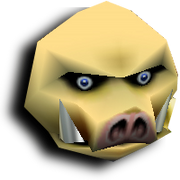
The Mask of Scents is believed to be a reference to Pigma Dengar from the Star Fox series; both are pigs and have black around the eyes, though Pigma lacks the tusks that the Mask of Scents has. It is one of five masks that are a supposed reference to Star Fox, along with the Bremen Mask, the Bunny Hood, Don Gero's Mask, and the Keaton Mask.
The mask may also be shaped like a pig because pigs can be used to smell and find truffles, a type of subterranean mushroom.
Mask of Truth[]
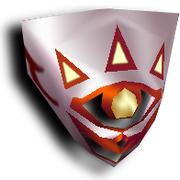
Mask of Truth
The Mask of Truth never turns its wearer into a monster by itself.
The man wears the mask because of greed. This is shown by both the story as to how he turned into and, when Link picks up the dog in the same room as the man while wearing the Mask of Truth, he is told that his master wore that mask due to his greed. Clearly, when the man put the mask on, he was performing an act of greed.
In Hyrule, specifically in the game The Legend of Zelda: Ocarina of Time, Link sees a family that is cursed due to its greed. The physical manifestation of the curse is spiders being dispersed throughout Hyrule, and the family themselves being turned into gigantic spiders. This curse being born from greed is shown to exist.
The location itself was known for spiders in the first place. Link can read a sign "Fearful Spider House" clearly referencing the cave behind it. Given that the dog is in good health and not dead due to starving, the cave was obviously referred to as the "Fearful Spider House" before the man went there. This place is tied to the curse, and it wasn't simply the place for the Gold Skulltulas to roam free due to its close proximity to where the man put on the mask. Instead it was basically "activated" for lack of a better term. The switch is performing an act of greed in or near it.
Monkey[]
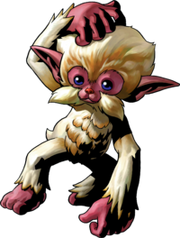
In Twilight Princess, monkeys aid Link inside the Forest Temple, which is implied to be their natural habitat. A female monkey guides Link on his journey to the Sacred Grove (much like Saria did in Ocarina of Time), suggesting the monkeys are actually transformed Kokiri, who, either by evolution or some other form of change, needed to better adapt to their changing environment. The monkeys also appear to have tattoos of the Kokiri symbol on their shoulders. The Forest Temple itself is theorized to be the remains of the Great Deku Tree from Ocarina of Time; this would also imply that Faron Woods, or some part of it, was once Kokiri Forest, which would also explain why the area is relatively uninhabited.
Hyrule Historia possibly debunks this theory, however, as it claims the only traces of the Kokiri left by the time of Twilight Princess was their symbol in the Forest Temple, implying they completely died out rather than evolving into a new form.
Multiple Ganon Theory[]
The Multiple Ganon Theory is the theory that there exists more than one Ganon/Ganondorf in the Zelda timeline, in much the same way that Link and Princess Zelda exist as more than one person throughout the Legend of Zelda series. Variations include ideas that Ganondorf is locked in the same cycle of reincarnation as Link, or that Ganon is a malevolent demon who possesses people, Ganondorf being one such host. Supporting the reincarnation idea, it is said by the Gerudo that only a single male is born into their tribe every one hundred years. Depending on the game, he is said to be destined to become either the King of the Gerudo or the guardian of the desert and the Gerudo.
Although the theory has been around for quite some time, most modern versions of this theory stem out of Ganondorf's back-story in The Legend of Zelda: Four Swords Adventures, which conflicts with Ganondorf's back-story in The Legend of Zelda: Ocarina of Time. In Four Swords Adventures the Gerudo talk about a man named Ganondorf who had been born and lived in the Desert of Doubt with them. They mentioned that he had grown into an evil man with a lust for power and had broken their laws by stealing a Trident deep in the desert that gave him incredible powers, such as transforming him into Ganon.
This is in direct contrast to the back-story Ganon was given in Ocarina of Time, in which he is acknowledged by many as the king of the Gerudo, and does not become Ganon until acquiring the Triforce of Power. Additionally, the back-story of The Legend of Zelda: Twilight Princess, which explains the actions of the Ganondorf from Ocarina of Time in an alternate timeline, says that a tribe of thieves, most likely the Gerudo, followed him in his attack on Hyrule, again showing that he was accepted as king.
There are only three logical explanations to these conflicting back-stories:
One is that a single Ganondorf had ventured to the desert and stolen the Trident, broke out of the seal he was placed at at the end of Four Swords Adventures but was not killed by Link, turned back into Ganondorf, and returned to the Gerudo later at a time that they were willing to acknowledge him as king. This would require that Four Swords Adventures take place before Ocarina of Time. The second explanation is that the game is not part of the overall storyline within the series, though official statements indicate that all the games from the main series are included in the official timeline document. The third explanation is that the Ganondorfs from the two games are separate incarnations, much like the many Links, Zeldas, and other characters who are seen multiple times throughout the series. This theory is supported by a quote at the end of Four Swords Adventures in which Princess Zelda calls Ganon an "ancient demon reborn". This is similar language to a line in The Legend of Zelda: The Wind Waker in which Ganondorf calls the game's incarnation of Link "The Hero of Time, reborn". Another solid point for this theory is the apparent death of Ganondorf/Ganon five separate times throughout the series. An individual Ganon is only shown to be resurrected once. Even with this resurrection, and the split timeline allowing a single individual Ganon to die twice, there would still need to be three separate Ganons in order to account for all of the presumed deaths. In order for all of the Ganons in the series to be the same, Ganon would have to have been brought back to life on two additional occasions not hinted at by any of the games, or survived at least two of his apparent deaths.
In The Legend of Zelda: Skyward Sword, Demise states that his hatred will be reincarnated and attack in a cycle without end. This is often interpreted as meaning that Ganon's repeated appearances are a result of this cycle. If Ganon as we know him is a result of Demise's hatred continuously reincarnating itself, there would be further support for the idea that multiple Ganons could continue to appear even as previous ones are slain. This would support the Multiple Ganon Theory as each Ganon would be a separate incarnation in this cycle, though all of them would share the same basic origin of forming from Demise's hatred.
While the Multiple Ganon Theory has yet to gain wide spread acceptance, it has nonetheless gained the respect of some timeline theorist and fans of the series.
Shigeru Miyamoto has stated that although each Link and Zelda are reincarnations, there is "only one Ganon". However, this statement may now be outdated or may have been made based on a lack of information, as Miyamoto is no longer as involved with the Zelda storyline as he previously was.
According to the Hyrule Historia, a second Ganondorf is born during the events leading to Four Swords Adventures. The book either implies or states directly that the rest of Ganon's appearances are the same being brought back to life, or versions of him in alternate timelines.
Mikau[]
It is strongly hinted that Mikau was romantically involved with Lulu, and could potentially be the father of her children, as she initially does not want to tell him that the Gerudo Pirates took her eggs. This is also supported by his determination to get the eggs back, and why the pair were walking hand in hand in Mikau's dying vision. Also, upon hatching, the newborn Zoras form into the musical notes of a song. This could be indicating the love for music they received from their supposed parents.
Nejiron[]
Nejirons bear striking resemblance to Gorons and may in fact be a variation of them, considering their names both end with "-ron". Another one may be that Neji- means imposter, and ron may mean goron, so it may be an imposter goron.
Pamela's Father[]

It is possible that Pamela's Father shares some sort of connection with Anton from The Legend of Zelda: The Wind Waker, as the two look mildly similar and wear the same style shirts.
Part Time Employee[]

The Part-time Employee looks exactly like the Man on the Roof and may be his Terminan counterpart.
Pols Voice[]
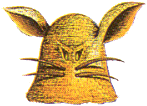
Pols Voice bear a resemblance to the Bunny Hood, a recurring mask in the series. This may not be a coincidence, however; when Link sells the Bunny Hood to the Running Man in The Legend of Zelda: Ocarina of Time, he states upon receiving the mask, "I bet with those long ears you can hear the voices." This quote may very well signify a connection between the Pols Voice and the Bunny Hood. He also states that Hyrule Field once was full of rabbits, but they are now extinct. This could also be a reference, as the Pols Voice look somewhat like rabbits.
Postman[]
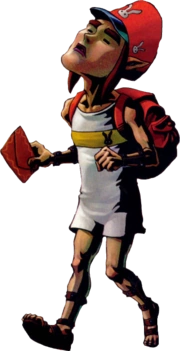
It is heavily implied that a member of the Rito tribe in The Wind Waker, Koboli, is a descendant of either the Running Man of Ocarina of Time or the Postman of Majora's Mask. This is due to the obvious similarities in facial appearance. Koboli's occupation also suggests that he is a descendent of the Postman; the text from the Nintendo Gallery explicitly states that he belongs to a family that has been of the mailing profession for generations.
Princess Zelda[]
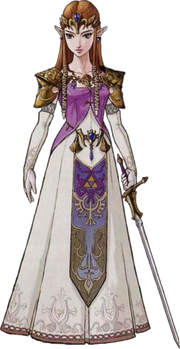
The relationship Zelda has with Link is close, possibly her closest. A popular theory among fans is that of a romantic relationship between some of the Zelda and Link characters in the Zelda series. Although never explicitly confirmed in a video game title, this theory is based on hints given in the games, interviews with the game creators, and content of the animated series, comics, and manga (although the last three are generally considered non-canonical).
One hint of a romance between Zelda and Link is given at the end of The Adventure of Link, when the awakened Princess apparently kisses Link under the falling curtain.
Some cutscenes in Ocarina of Time featuring the two together have been interpreted as signs of an attraction. While Link and Zelda are escaping Ganon's Castle, Zelda will additionally show her concern for Link by shouting out whenever he is hurt. Moreover, in the game's final scene, Zelda and Link are floating in the sky together, sharing a decidedly sentimental (if not necessarily romantic) moment where Zelda apologies for involving Link in the events of the game and seems saddened by the situation. She also stated that she will not forget the time she spent with him in the Child Timeline as shown in Majora's Mask through Link's memory.
In addition, if the Oracle games are played as sequels to each other, the ultimate ending sequence shows Zelda lightly kissing Link on the cheek. Link swoons while hearts float above the pair's heads, and Zelda looks away, blushing. In The Wind Waker, when Zelda is asked to stay in hiding in Hyrule Castle while Link restores power to the Master Sword, she waves goodbye to Link, asking him to be careful.
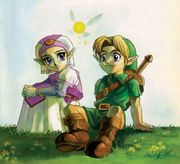
Spirit Tracks features several moments that can be interpreted romantically. Early in the game during the Graduation Ceremony, Zelda walks into the room in front of Link, who is bowing down respectfully. Link then looks up and gasps, blushing at her in amazement. He is then scolded by Chancellor Cole for raising his head without permission. Later, when Zelda's spirit is separated from her body following the first encounter with Chancellor Cole and Byrne, Link is the only one who can see her besides the Lokomos, demonstrating a clear and strong bond between himself and the Princess. After Zelda and Link defeat Byrne in the Tower of Spirits, Byrne, disbelieving, comments that he was beaten by two humans. Zelda, while still possessing a Phantom, says that when she and Link combine their strength, no one can defeat them. Link turns to her, surprised. The background turns white and Zelda's Lullaby plays as they both laugh and high-five, gazing at each other all the while. Toward the end of the game, before the final battle against Malladus, Zelda is reunited with her body, and is no longer able to levitate. Link runs underneath her to catch her as she falls, and she lands on top of him and knocks them both to the ground as well as knock Link out for a few seconds. Upon awakening, Zelda, overjoyed to have her body back, embraces Link, causing him to blush. Finally, after Malladus is defeated, Zelda and Link watch Anjean and Byrne's spirits ascend to the heavens. The camera then lowers to show Zelda and Link holding hands while Zelda's Lullaby plays in the background. After the credits, a short cut scene shows Zelda gazing at a picture of Link on the Spirit Train with her flying beside him, which she keeps on her desk. she may also wave at Link depending on his answer to a question Zelda asked before.
Skyward Sword has several noticeable romantic moments between Link and Zelda. Early in the game, Zelda wants Link to be the first to see her outfit for the Wing Ceremony. She worries over him and she does not want him to fail at becoming a knight. When Link's Crimson Loftwing is hidden by Groose, Zelda assists Link in finding his Loftwing. After Link wins the Wing Ceremony, Zelda jumps off the ledge and Link catches her almost as if she was expecting him to. She then congratulates him on winning. Afterwards, Zelda mentions that she is very happy to be atop the Statue of the Goddess with him. She also gets extremely close to him and almost implies that the two are to kiss, before she pushes him off the statue. Afterward, Zelda bashfully asks Link to go out flying which they do. She then tells Link how amazing the day was, and that she would remember it forever. At the Temple of Hylia, when Zelda states she must seal herself to keep Demise in place, she sheds tears of sadness and states before all this, she was happy just being with Link on Skyloft, demonstrating a deep level of feelings for Link. Link desperately tries to stop her and when she is sealed, Link lowers his head in sadness, showing his deep feelings for her. Much later in the game, when Link releases Zelda from her sealed state, Link runs up and catches her from falling and both of them hug and walk out smiling at each other, holding hands, before Ghirahim ruins the tender moment. During the ending, Zelda asks what Link will do now. Link sweetly smiles at her while their Loftwings fly off toward the sky, implying that he chose to stay on the Surface to live with Zelda.
A Link Between Worlds features some gossip told to Link by the Rumor Guy. He tells Link that one of the castle staff had seen Zelda sneaking off every night. When she followed her, she saw Zelda staring at the painting in Hyrule Castle depicting the Link and Zelda from A Link to the Past cuddling with each other, implying they became more intimate with each other. This also hints the Zelda in A Link Between Worlds wants to have a similar relationship with the Link of her time.
The game creators also seem to be fond of the idea of romance between the characters.
Though never directly stated in-game, Shigeru Miyamoto revealed in an interview conducted by Famimaga 64 that Navi is jealous of Princess Zelda and has feelings for Link.
Another less popular theory among fans is that Link and Zelda are related by blood, either as siblings or more distantly. Even though rumors to this effect started with the infamous "Save the Princess... Zelda is your... ... ..." line from A Link to the Past (later reported as a mistranslation), the theory generally revolves around the Link and Zelda from Ocarina of Time.
A possible indication of a blood relation between the two in Ocarina of Time is their physical resemblance: they both have blonde hair, blue eyes, and similar facial features. They also have similarly shaped heads. Graphics limitations could be responsible for some of this similarity, however. Certain dialogue could also be perceived as implying a blood relation: the ghost Sharp comments that Link reminds him of Zelda, and that Link "may have some connection with the Royal Family". Link's connection to the Royal Family is highlighted throughout the game, with Link often playing Zelda's Lullaby to verify it. The fact that Impa agrees to teach a strange boy a song only Royal Family members are allowed to know could also be interpreted as a hint at Link's blood relation to Hyrule's Royal Family.
Additionally, Zelda seems to recognize Link's name upon their first meeting. This could be attributed to her prophetic abilities, although the boy in her dreams seemed to be a largely abstract figure, with no defining traits aside from the presence of a guardian Fairy and a Spiritual Stone. This line of dialogue has often been regarded as a sign that the two have met before, although this could only have occurred when Link was a baby per the Deku Tree Sprout's account of Link's coming to Kokiri Forest. It is also worth noting that while the King of Hyrule is clearly identified as Zelda's father, no mention is made of a Queen. Meanwhile, Link's mother is stated to have died shortly after reaching the forest, but no information is given concerning his father. Given these facts, it is possible that Zelda and Link share the same parents, making them siblings.
ReDead[]
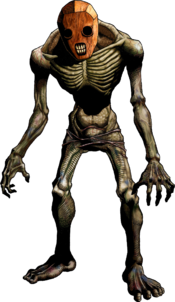
- "During Ganondorf's dark reign, many evil beings walked the earth, but none were as horrible as the ReDead. These skeletal creatures froze people who strayed too close, then they sucked the life from the unfortunate victims."
- — Nintendo Power Player's Guide description
ReDeads (リーデッド Rīdeddo?) are recurring enemies in the Legend of Zelda series. They are highly emaciated, undead humanoid creatures, closely resembling zombies. They are found in dark and distant locations such as Hidden Holes and dungeons. ReDeads are capable of completely halting the movement of their prey with their gaze when they come close; concurrently, they emit blood-curdling screams to terrify their unfortunate victim. They will then close in on their stunned victim, and in most games will attach to them to drain their life energy. ReDeads are considered to be among the most frightening enemies of the Legend of Zelda series.
Origin[]
It is possible that ReDeads were once regular, deceased Hylians who happened to be re-animated through exposure to dark magic, or that they are, like Poes, restless spirits wandering the world of the living. Considering the abundance of ReDeads found in the devastated Hyrule Castle Town of the future, as well as underneath the Kakariko Graveyard and inside the Shadow Temple, this theory seems plausible.
Burial Customs[]
The differences in appearance and habits between the different incarnations of ReDeads may suggest changes in burial customs over the passing of time. ReDeads found in Ocarina of Time and Majora's Mask are sometimes encountered underneath graves, and appear to be wearing carved Spooky Masks over their faces. ReDeads found in The Wind Waker are decidedly teal-colored. Since these corpses were all buried below sea level, it is possible they were punished for evil doings, and forced to haunt Hyrule forever.
Skull Kid (Character)[]

It is widely believed, and heavily implied in Majora's Mask, that the Skull Kids in Ocarina of Time and Majora's Mask are one and the same. While no outright statement is ever made regarding this, it seems beyond a reasonable doubt this is what the games' creators intended.
Firstly, upon encountering Link in the Lost Woods after having ambushed him, the Skull Kid appears to recognize Link, but deems it not to be a problem. Later, after the Skull Kid is removed from the influence of Majora's Mask, he tells Link that he smells the same as "that fairy kid who taught [him] that song in the woods": in Ocarina of Time, Link plays "Saria's Song" to a Skull Kid in the Lost Woods, who becomes his friend after this.
Additionally, Link sells the Skull Mask to this same Skull Kid, indicating a preexisting interest for masks which could have motivated the Skull Kid's theft of Majora's Mask. Lastly, after the end credits of Majora's Mask, the final image shown is a stump bearing carvings of the Skull Kid, Link, Tatl, Tael, and the Four Giants. After a certain amount of time passes, part of "Saria's Song" will play.
It is also possible that this Skull Kid is either the same Skull Kid, or an ancestor to the Skull Kid from The Legend of Zelda: Twilight Princess. This is supported by the fact that that Skull Kid knows "Saria's Song".
Split Timeline[]
It is speculated by some that alternate worlds such as the Twilight Realm and Termina may be unaffected by the timeline split. However, while these two realms are alternate dimensions, there is no evidence to support the idea that they exist outside of linear time. Both realms have demonstrated the ability to receive beings from the Child Timeline and return them to the Child Timeline when they exit back into Hyrule. There is no reason to believe that these two realms would only exist as a single timeline, or that they could "prioritize" inputs from one timeline, and later output these into both the timelines.
In addition, the renowned Youtube show, Game Theory, dismissed the Zelda Timeline, particularly the Defeat Timeline (in where Link fails on his quest) on the grounds that "the hero cannot be simultaneously victorious and defeated". Elaborating, he explained that with Link defeating Gannondorf, two perfectly possible timelines are created; However if Link dies at any point in his journey another separate timeline is created. Explaining that the only way for all 3 timelines to exist is the Many Worlds Theory (the theory that all possible pasts and futures exist in separate timelines).
Stalchild[]
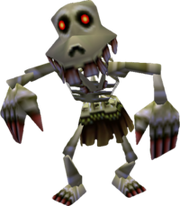
It is possible that the Stalchildren of Ocarina of Time are Kokiri who have left the Kokiri Forest, thus turning into Stalchildren. They could also be Hylians who are suffering the effects of the Lost Woods, with a Stalchild being an intermediary stage between a Hylian and a Stalfos. However, since the Stalfos transformation is supposedly imposed on those unable to find their way out of the Lost Woods, it seems unlikely that such individuals would appear in Hyrule Field. Additionally, Kokiri are seen outside the Forest during the end credits of Ocarina of Time, suggesting that their law of "Those who leave the forest will die" is simply a warning of the dangers posed by the outside world.
Stone Tower[]
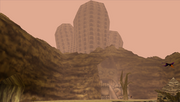
- "To return true light to this land, you must seal the doors of Stone Tower where the winds of darkness blow through. But Stone Tower is an impenetrable stronghold. Hundreds of soldiers from my kingdom would not even be able to topple it."
- — Igos du Ikana
Stone Tower is a location from The Legend of Zelda: Majora's Mask. It stands to the east of the abandoned kingdom of Ikana. Link must climb the tower in order to reach the entrance to Stone Tower Temple, the game's fourth dungeon.
Stone Tower is easily the largest crafted object in Termina, its height being surpassed by only the mountain of Snowhead; it is multiple times taller than the Clock Tower. It has countless holes on the surface, which could be windows through which boulders fall. The interior is a huge vertical shaft with floating blocks, which move when a certain switch is pressed. The black abyss below the first level implies that there are many sub levels.
The tower contains many platforms onto which Link must climb using the Hookshot. The trios of floating blocks found within must be arranged into a line across which Link can jump to reach the next area. The switches in the tower must remain depressed for their corresponding blocks to remain in place, so Link must use the Elegy of Emptiness to leave shells of his different forms on each switch while he crosses. Link's climb up the tower is hindered by falling boulders, Beamos, and Fire Keese. An Owl Statue can be found near the top, across from the entrance to Stone Tower Temple.
The Garo as the Makers of Majora's Mask[]
The tower has clear connections to the Triforce, Majora's Mask, and the Four Giants. The fact that the Eastern Giant is held at the top of the tower seems to indicate that he was tasked with protecting Stone Tower Temple. The presence of the Triforce also is puzzling, as who ever built the tower obviously had knowledge of its existence. It is possible the Garo, the shadow warriors whose leader is found within Stone Tower Temple, were the makers of Majora's Mask, and that the pocket dimension Link fights Twinmold in was once a temple they had built to house the mask, or possibly the place in which they sealed it away since gamers learn that the "ancient tribe" sealed the mask away "in shadow." This is contradicted by information from Pamela's Father, who states that the Garo are spies from a enemy nation, implying they came from farther away. Due to the statement of Ikana's Igos du Ikana that his army could not topple Stone Tower, it seems clear that whoever was inhabiting the temple eventually became enemies of the kingdom of Ikana. Igos also mentions that when the "doors of Stone Tower" were opened, a curse flowed from its summit that laid waste to the entire region. This could possibly be the reason he and his soldiers attempted to climb the tower, to shut off the source of the curse and to destroy the ones that opened the doors of Stone Tower.
The Ancient Ones[]
Another more likely possibility is that the "Ancient Ones" that used Majora's Mask built the tower and Stone Tower Temple. Who ever built the tower had some knowledge of magic, since they infused the Red Emblem with the power to invert the tower and reverse gravity. This would also explain the appearance of the Triforce both within the temple itself and on the statues that line the way to Ikana Canyon, since the Ancient Ones were likely skilled in magic and probably knew of the Triforce due to its limitless magical power.
Avian Species[]
This theory states Stone Tower was originally a home for an ancient Avian race (such as the Oocca or the Rito). This race built Stone Tower, but not for the same purposes as its later uses were. The many "holes" on the temple served as living quarters for the members of this race, and the temple perhaps served as a town center or some similar thing (such as a place of worship for the Giant of the Eastern Canyon). The evidence of this is that the tower has many holes that serve very little practical purpose and that it would be very difficult to traverse, let alone make, a place with so many gaps unless the beings that made the tower had wings.
Termina's Tower of Babel[]
Another theory suggests that Stone Tower was built by the ancients of Termina to persecute Din, Nayru, and Farore. One of the leading clues for this theory is the obscured appearance of the Triforce, as it appears on the moving stone blocks within the tower, depicted as being licked under the crotch of a sitting creature – a motif suggested to be an expression of profanity, as a statement of rejecting the Triforce and Golden Goddesses. The theory implies that the tower was raised to declare a war against the heavens, in contempt of the idea that the goddesses would be their true creators. It also relies on the possible event that the goddesses would have made their presence known for the ancient royal family of Ikana – as they had for the royal family of Hyrule – in conjunction with the fact that the people of Termina had already proclaimed the Four Giants as their guardian deities and creators of the four worlds. It is suggested that the goddesses would have been rejected in favour of the Four Giants, while also provoking a rage for posing as what would have been perceived as blasphemy. The theory also suggests that the war could have been subject to sexistic views, pointing towards the phallic structure of the Stone Tower itself, including the four phalluses surrounding the temple entrance.
Swamp Spider House[]
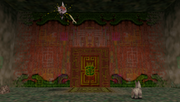
The Mask of Truth never turns its wearer into a monster by itself.
The man wears the mask because of greed. This is shown by both the story as to how he turned into a monster and, when Link picks up the dog in the same room as the man while wearing the Mask of Truth, he is told that his master wore the mask due to his greed. Clearly, when the man put the mask on, he was performing an act of greed.
In Hyrule, specifically Ocarina of Time, Link sees an entire family that is cursed due to its greed. The physical manifestation of the curse involved spiders dispersed throughout Hyrule and the family being turned into spiders. This curse being born from greed is shown to exist.
The location itself was known for spiders in the first place. Outside, Link can read a sign stating, "Fearful Spider House," clearly referring to the cave behind it. Given the fact that the dog is in good health and not dead due to starving, the cave was obviously referred to as the Fearful Spider House before the man went there. This place is tied to the curse, and it was not simply the place chosen for the Gold Skulltulas to roam free due to its close proximity to where the man put on the mask. Instead, it was simply "activated", for lack of a better term. The switch is performing an act of greed in or near it.
Swamp Spider House Resident[]
The Mask of Truth never turns its wearer into a monster by itself.
The man wears the mask because of greed. This is shown by both the story as to how he turned into a monster and, when Link picks up the dog in the same room as the man while wearing the Mask of Truth, he is told that his master wore the mask due to his greed. Clearly, when the man put the mask on, he was performing an act of greed.
In Hyrule, specifically Ocarina of Time, Link sees an entire family that is cursed due to its greed. The physical manifestation of the curse involved spiders dispersed throughout Hyrule and the family being turned into spiders. This curse being born from greed is shown to exist.
The location itself was known for spiders in the first place. Outside, Link can read a sign stating, "Fearful Spider House," clearly referring to the cave behind it. Given the fact that the dog is in good health and not dead due to starving, the cave was obviously referred to as the Fearful Spider House before the man went there. This place is tied to the curse, and it was not simply the place chosen for the Gold Skulltulas to roam free due to its close proximity to where the man put on the mask. Instead, it was simply "activated", for lack of a better term. The switch is performing an act of greed in or near it.
It is possible that the Swamp Spider House Resident's dog used to be a dog that competed in Doggy Racing at the Romani Ranch. This is supported by the fact that if Link picks up the dog wearing the Mask of Truth after completing the Spider House in that three-day cycle, it will comment on how it misses 'the ranch'.
Them[]

"They" are sometimes presumed to be extraterrestrial beings, as both their behavior and appearance is similar to that of stereotypical aliens; for instance, unexplained real-life abductions of cattle are often attributed to aliens. The ball of light in which "They" arrive is similar to some depictions of a space ship; furthermore, the light beams which they use to transport the cows to their ball of light is reminiscent of the fictional invention known as the tractor beam. Their similarity to reported sightings of the Flatwoods monster, believed to be have been an extraterrestrial entity, also supports this theory.
While its canonical status remains in question, the track listing for The Legend of Zelda: Majora's Mask Original Soundtrack names the song that plays during the battle against "Them" as "Alien Attack". However, in the game, "They" are referred to as ghosts by both Romani, Cremia, and the Bombers' Notebook. This may be a false assumption though on the part of Romani, as she is likely aware of the existence of ghosts, but may not have a concept of aliens from another planet. When Cremia refers to "Them" as ghosts, however, she is probably regarding the stereotypical beliefs that a childish youth such as Romani may have. This is supported because Cremia puts the word "ghosts" in quotation marks, suggesting that she is saying this in a disapproving manner.
Tingle[]
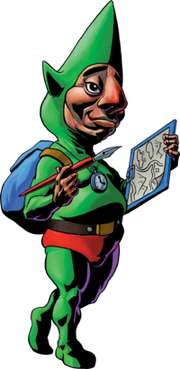
A character named Purlo appears in The Legend of Zelda: Twilight Princess. Purlo is possibly a reference to what Tingle would look like if he was a more realistic character. Purlo is the manager of the STAR Game in Hyrule Castle Town, and he wears a similar costume to Tingle. He is also obsessed with Rupees, much like Tingle. Unlike Tingle though, Purlo has an unfriendly attitude towards others.




